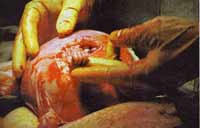Pregnant baby girl born in Saudi Arabia
An outstanding incident took place in the medical practice of Saudi doctors. A year-old girl turned out to be pregnant. Doctors said that it was the first incident in the history of modern medicine. Arab media outlets discuss whether the removal of the fetus from the baby girl is going to be considered a murder.

It turned out that the mother of the pregnant baby originally had two embryos during her pregnancy. One of the embryos began to develop in the uterus of the other child. In spite of the fact that doctors describe the incident as unique, there can be other similar examples found in history.
A 36-year-old farmer had the embryo of his twin brother removed in the town of Nagpur, India, in 2006. The man asked for medical help only after his swollen belly hampered his breathing.
Doctors were certain that the man had a gigantic tumor in his belly. However, they found fragments of human genitalia, hairs, limbs and jaws in the patient and finally removed a weird underdeveloped creature having legs and arms with long nails.
In 2002, Indian doctors found a fetus in the body of a six-month-old boy. The dead fetus, which surgeons removed from the boy, weighed one kilo, whereas the boy himself weighed 6.5 kilos.
The anomalous phenomenon is known as fetus in fetu. Such incidents are extremely rare: an embryo inside an embryo may appear once in 500,000 pregnancies. The phenomenon always occurs at an early stage of pregnancy. As a rule, the fetuses die in mother’s womb.
It may also happen that a child with a fetus inside survives the entire pregnancy. In this case the embryo continues to live inside its owner’s body like a trapped parasite.
A fetus in fetu can be considered alive, but only in the sense that its component tissues have not yet died or been eliminated. Thus, the life of a fetus in fetu is inherently limited to that of an invasive tumor. In principle, its cells must have some degree of normal metabolic activity to have remained viable. However, without the gestational conditions attainable (so far) only in utero with the amnion and placenta, a fetus in fetu can develop into, at best, an especially well-differentiated teratoma; or, at worst, a high-grade metastatic teratocarcinoma. In terms of physical maturation, its organs have a working blood supply from the host, but all cases of fetus in fetu present critical defects, such as no functional brain, heart, lungs, gastrointestinal tract, or urinary tract. Accordingly, while a fetus in fetu can share select morphological features with a normal fetus, it has no prospect of any life outside of the host twin. Moreover, it poses clear threats to the life of the host twin on whom its own life depends.
Also read: Doctors remove parasite child
Subscribe to Pravda.Ru Telegram channel, Facebook, RSS!




